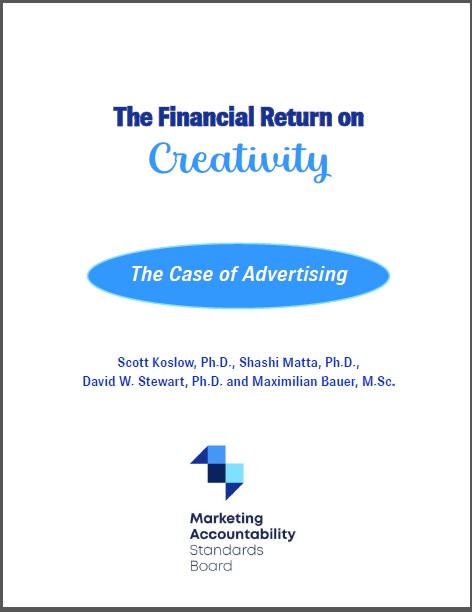An extensive review of marketing research literature has produced a new definition of “marketing creativity,” published in the Universal Marketing Dictionary. Considered one of the most important and unique contributions of the marketing and advertising functions, creativity serves as a crucial driver of firm profitability and sustainability, enabling companies to increase business performance and gain a sustainable competitive advantage.
 According to The Financial Return on Creativity: The Case of Advertising (MASB, Oct. 2024), “it is perhaps surprising that there are concerns about current investment in creativity, its contributions, and its effectiveness, at least as measured by financial performance,” with “some arguing that there is a declining trend in the effectiveness of creatively awarded campaigns.”
According to The Financial Return on Creativity: The Case of Advertising (MASB, Oct. 2024), “it is perhaps surprising that there are concerns about current investment in creativity, its contributions, and its effectiveness, at least as measured by financial performance,” with “some arguing that there is a declining trend in the effectiveness of creatively awarded campaigns.”
This review of the literature on creativity, part of the Marketing Accountability Standards Board’s Measuring Creativity Initiative, focuses on the definition of, management of, and financial return on creativity in advertising.
The authors are Scott Koslow, Ph.D., Professor of Marketing at Macquarie University in Sydney, Australia; Shashi Matta, Ph.D., Professor of Innovation & Creativity in the Ingolstadt School of Management at the Catholic University of Eichstätt-Ingolstadt in Germany; Maximilian Bauer, doctoral student in the Ingolstadt School of Management, and David W. Stewart, Ph.D., President Professor (Emeritus) of Marketing and Business Law at Loyola Marymount University. Stewart presented initial findings during MASB Summer Summit 2023 at Marquette University.
The review and consideration of more than 100 publications resulted in this definition:
Marketing creativity is the application of creativity to advertising, messaging, promotional strategy, packaging, product development, and other related areas. Given the general definition of creativity, this translates as developing new and better solutions to marketing problems. These can have an emotional purpose, a practical purpose, or both. For example, the intention of an advertisement may be to inspire an emotional reaction in its audience, which results in useful, real-world impact such as increased sales, increase share of market, and improved image and attitudes towards a brand.
The new MASB paper, available from MASB PUBLICATIONS, includes a Summary of Best Practices for Development of Advertising Content that ends with, “The goal of advertising is not to be creative; creativity is a means to an end.”
The authors believe that “a large impediment to the justification of content development activities and other marketing actions is an absence of the knowledge and skills required to understand how businesses operate, how marketing actions influence business performance, and how to translate marketing actions into financial projections and performance.”
The MASB Measuring Creativity Initiative is exploring the degree to which evolving technologies, such as artificial intelligence and machine learning, may facilitate or inhibit effective advertising in the future. For more information, contact info@themasb.org.
